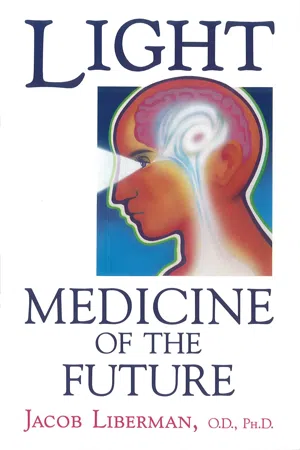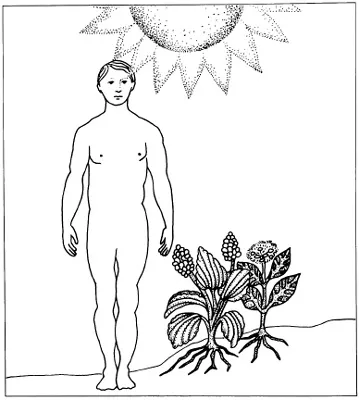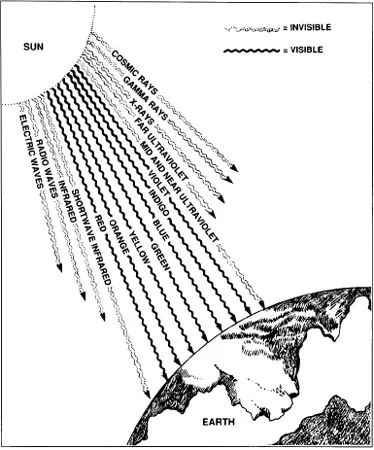
eBook - ePub
Light: Medicine of the Future
How We Can Use It to Heal Ourselves NOW
Jacob Liberman
This is a test
- 304 pages
- English
- ePUB (adapté aux mobiles)
- Disponible sur iOS et Android
eBook - ePub
Light: Medicine of the Future
How We Can Use It to Heal Ourselves NOW
Jacob Liberman
Détails du livre
Aperçu du livre
Table des matières
Citations
À propos de ce livre
Light: Medicine of the Future challenges the modern myth that the sun is dangerous to our well-being and claims that technological advancements, such as most fluorescent lighting, sunglasses, tanning lotions, and our indoor lifestyles, may be more harmful than helpful. Integrating scientific research, clinical experience, and his own insights, Dr. Jacob Liberman has worked effectively with more than 15, 000 individuals, from the learning disabled and physically/emotionally traumatized to business executives and Olympic athletes. The book discusses the use of light in the treatment of various cancers, depression, stress, visual problems, PMS, sexual dysfunction, learning disabilities, and the human immune system.
Foire aux questions
Comment puis-je résilier mon abonnement ?
Il vous suffit de vous rendre dans la section compte dans paramètres et de cliquer sur « Résilier l’abonnement ». C’est aussi simple que cela ! Une fois que vous aurez résilié votre abonnement, il restera actif pour le reste de la période pour laquelle vous avez payé. Découvrez-en plus ici.
Puis-je / comment puis-je télécharger des livres ?
Pour le moment, tous nos livres en format ePub adaptés aux mobiles peuvent être téléchargés via l’application. La plupart de nos PDF sont également disponibles en téléchargement et les autres seront téléchargeables très prochainement. Découvrez-en plus ici.
Quelle est la différence entre les formules tarifaires ?
Les deux abonnements vous donnent un accès complet à la bibliothèque et à toutes les fonctionnalités de Perlego. Les seules différences sont les tarifs ainsi que la période d’abonnement : avec l’abonnement annuel, vous économiserez environ 30 % par rapport à 12 mois d’abonnement mensuel.
Qu’est-ce que Perlego ?
Nous sommes un service d’abonnement à des ouvrages universitaires en ligne, où vous pouvez accéder à toute une bibliothèque pour un prix inférieur à celui d’un seul livre par mois. Avec plus d’un million de livres sur plus de 1 000 sujets, nous avons ce qu’il vous faut ! Découvrez-en plus ici.
Prenez-vous en charge la synthèse vocale ?
Recherchez le symbole Écouter sur votre prochain livre pour voir si vous pouvez l’écouter. L’outil Écouter lit le texte à haute voix pour vous, en surlignant le passage qui est en cours de lecture. Vous pouvez le mettre sur pause, l’accélérer ou le ralentir. Découvrez-en plus ici.
Est-ce que Light: Medicine of the Future est un PDF/ePUB en ligne ?
Oui, vous pouvez accéder à Light: Medicine of the Future par Jacob Liberman en format PDF et/ou ePUB ainsi qu’à d’autres livres populaires dans Medicine et Alternative & Complementary Medicine. Nous disposons de plus d’un million d’ouvrages à découvrir dans notre catalogue.
Informations
Sujet
MedicineSous-sujet
Alternative & Complementary MedicinePART ONELet There Be Light
1

The Human Photocell
Have you ever wondered why we call the process of profound human evolution "enlightenment" or why the portion of the galaxy in which we live is called the "solar system"? Doesn't the term "solar system" imply that human beings are of, or derived from, the sun? Why do people frequently make statements such as "Lighten up" or "You light up my life"? How does living in the light differ from experiencing the dark night of the soul? Is it possible, as renowned physicist David Bohm states, that "all matter is frozen light"?1 Could it be that our evolution, in some deep way, is related to our ability to take in and utilize light on a spiritual level as well as a physical level? These questions, and many others, are now being looked at scientifically, rather than just metaphysically or spiritually. The visions of clairvoyant sages of the past may not be so different from the scientific discoveries of the present. We are now in an era of accelerated scientific discovery, and the gap between scientific knowledge and "intuitive" knowing is gradually being bridged.
The idea of light as an integral part of all life and creation has been evident since the beginning of time. Sunlight, our major source and provider of light, warmth, and energy, not only sustains all life on Earth, but it sustains the Earth itself. It not only provides plants with the energy for photosynthesis, which in turn sustains the lives of all animals and humans, but also is the source of much of our knowledge, since most learning occurs by way of our eyes.

Figure 1. Sunlight: sustainer of life.
Sunlight is composed of a variety of energies that are transmitted to Earth in the form of electromagnetic waves. Only a small portion of these waves actually reach the Earth's surface, and only about 1% of the total electromagnetic spectrum is thought to be perceived by the eye. This visible portion of the electromagnetic spectrum, containing all the colors of the rainbow from violet (with the shortest wavelength) to red (with the longest wavelength) is a most important key to human functioning and evolution. Our lives, health, and well-being are truly dependent upon the sun.

Figure 2. The sun's electromagnetic waves.
NIGHT AND DAY
When early humans first opened their eyes in the morning, they must have recognized that the light of each day brought with it a new beginning. Throughout history, we have recognized that this new beginning couples inspiration with increased physiological activity, heightened energy, and action. Each sunrise, a transition from the restful darkness of night to the energetic brightness of day, infuses life into all living things. (See color plates 1-4.)
Flowers open, animals and humans awaken, the world is energized, and a new day begins. Day is conceived and represented by the yellow of the sun, the blue of the sky, and the green of the Earth. As the day progresses, environmental color changes become evident, as well as their corresponding effects on all living things. The end of the day, beginning with the red-orange of sunset flowing into the dark blue of night, initiates a gradual slowing down of all physiological activity, followed by tranquility and rejuvenation. (See color plates 5-8.) The occurrence of this colorful transition from day to night dramatically represents the internal shifting of gears taking place within all living things. As nature gradually moves from one end of the color spectrum (red-orange of day) to the other end (dark blue of night), our bodies also shift from one mode of function (work) to another (rest).
Just as the shifting of gears in an automobile requires passing through the gear called "neutral," so this same phenomenon occurs in nature. Prior to the brightness of day shifting into the darkness of night, a well-known "flash of green" is frequently reported. Green, the center of the visible color spectrum, signifies the "neutral zone" or "drift course" through which all living things pass prior to entering a new phase of functioning or of life itself. From humanity's experience of the very first sunrise to the sunsets of the present, we continue to be awed by the beauty, power, life-creating, and life-sustaining properties emanating from light. It would appear, then, that our physiological and emotional centers are synchronized with nature by way of light, and that we truly seem to be the offspring of nature.
THE RHYTHM OF LIFE
Based on the awareness that daily color variations in the environment are intimately connected to the body's daily rhythmic changes, humans have recognized that seasonal color changes also reflect biological alterations within all living things. For instance, traditional Chinese acupuncturists, recognizing these biological alterations, routinely recommend treatments at the change of the seasons.
Thus, the seasons and their characteristic color changes have become a universal reflection of the role that color plays in different aspects of life experiences. (See color plates 9-12.) For instance, farmers have always known that there are different seasons for planting, growing, and harvesting. They have observed that seasonal variations and intensity in daylight control the budding, growth, and dormancy of plants. It is also apparent that animals are as involved as plants in this solar connection, inasmuch as their hibernation, migration, and breeding occur seasonally and thus appear very much related to changes in ambient lighting.
In humans, exposure to sunlight significantly influences a host of physiological and psychological functions. Among these, fertility and mood are two of the most profoundly affected. This can be seen in many northern European countries, such as Norway and Finland, where months of darkness occur annually. In these countries, a direct correlation has been found between decreased exposure to sunlight and a higher incidence of irritability, fatigue, illness, insomnia, depression, alcoholism, and suicide. Interestingly, it has been found that in Finland more children are conceived during the months of June and July, when the sun shines approximately 20 hours per day, than during the winter months.2
THE SUN: THE ORIGINAL HEALER
From the initial biblical statement "let there be light" to the idea of being "enlightened," light has played a consistent role in the development of all living things. The ancient Egyptians, Romans, Greeks, and other major cultures made significant medical uses of light. Although Egyptian physicians were the first to use color for healing,3 the Greeks were actually the first to document both the theory and practice of solar therapy.4 Heliopolis, the Greek city of the sun, was famous for its healing temples, in which sunlight was broken up into its spectral components (colors), and each component was used for a specific medical problem. Herodotus, the father of heliotherapy (a medical therapy involving exposure to sunlight) wrote that
exposure to the sun is highly necessary in persons whose health needs restoring and who have need of putting on weight. In winter, spring, and autumn, the patient should permit the rays of the sun to strike full upon him; but in summer, because of the excessive heat, this method should not be employed in treating weak patients.5
Color, being a manifestation of light, held a therapeutic as well as divine meaning for these historical cultures.
MODERN SCIENCE RECOGNIZES THE VALUE OF LIGHT
The therapeutic uses of light have been known to many cultures for thousands of years. What are the effects of light deprivation? Probably the first direct reference in modern scientific literature regarding the influence of the sun's light on normal human growth is found in the book Macrobiotics, written in 1796 by Hufeland. He wrote, "Even the human being becomes pale, flabby, and apathetic as a result of being deprived of light, finally losing all his vital energy—as many a sad example of persons sequestered in a dark dungeon over a long period of time has demonstrated." Can you imagine how you would feel if every day was cloudy, with no direct sunshine? Or if you lived in a country with several months of darkness yearly? How about if you were confined to spending most of your time indoors? Isn't this, in fact, what most people do, and consider normal, from early childhood on? Could this possibly be the reason why people who work indoors frequently become overweight, pale, and lacking in vitality? Have we sentenced ourselves, through our lifestyles, to living as prisoners in modern-day fluorescent dungeons? As actor Tom Hanks says in the movie Joe vs. the Volcano, "These fluorescent lights are sucking the life out of me!"
More recently, Albert Szent-Gyorgyi, Nobel Prize winner and the discoverer of vitamin C, has recognized how profoundly light and color affect us. From his work he concluded that "all the energy which we take into our bodies is derived from the sun."6, 7 He saw that, through the process of photosynthesis, the sun's energy is stored in plants, which are in turn eaten by animals and humans. Digestion and assimilation by animals and humans are concerned with breaking down, transferring, storing, and utilizing this light-created energy.
Szent-Gyorgyi discovered that many enzymes and hormones involved in processing this energy are colored and very sensitive to light. As a matter of fact, when they are stimulated by selected colors of light, these enzymes and hormones frequently undergo molecular changes that alter their original colors. These light-induced changes significantly affect the power of these enzymes and hormones to cause dynamic reactions within the body. It also demonstrates that the apparent color of something might be a strong indicator of its molecular structure. Szent-Gyorgyi is saying that light striking the body can literally alter the basic biological functions involved in processing the body's fuel, which powers our lives. If color and light have such a powerful effect on us, what, then, might be the effect of living under light that is significantly different from sunlight? Perhaps this might be similar to the difference between running a car on inexpensive, regular fuel versus premium, high-octane fuel!
Similar conclusions were reached by Martinek and Berezin in 1979.8 They found that light and color can play a remarkable role in how effectively certain enzyme systems regulate biological activity within the body. Specifically, they found that (a) some colors of light can stimulate certain bodily enzymes to be 500% more effective; and (b) some colors can increase the rate of enzymatic reactions, activate or deactivate certain enzymes, and affect the movement of substances across cell membranes. These findings seem to place light in a very powerful position as a regulator of many biological functions within the body.
Color may also indicate a person's stage of life or state of consciousness. I believe that light not only affects us, but that our state of consciousness determines how we use light. Consider how fee...